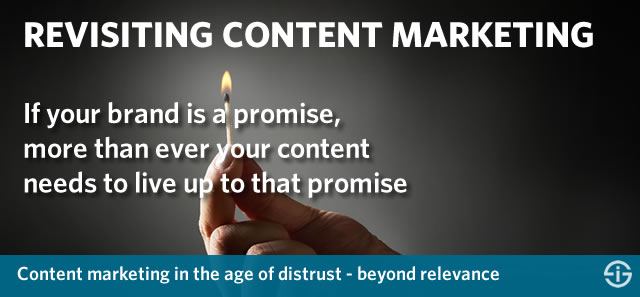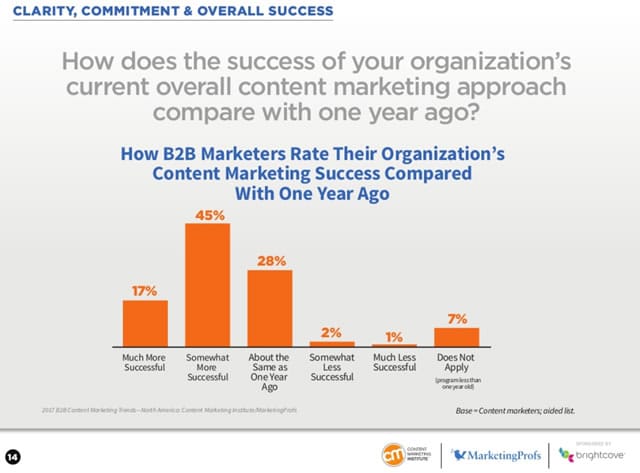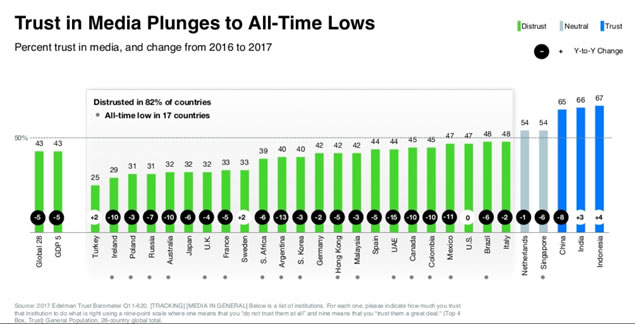Content marketing has become mainstream. For many companies it’s a component of their marketing strategies. Content marketing experts look at 2017 and the next years with predictions which are increasingly related with emerging or maturing technologies.
What’s the role of artificial intelligence in content marketing? How can we leverage IoT in content marketing? In which way can we better use (big) data and automation to personalize more, ideally in real-time? What about VR and AR? And even: how will technologies soon enable us to automatically create content?
The less technology-oriented content marketing experts explain which channels and formats are poised to grow: print is back, video and visual are key, short is the way to go (or longreads are better), mobile is a must and even email is back (from never having been away).

Content marketing beyond contextual relevance: the human connection, interaction and experience
It’s good to look at all these evolutions and understand how they can help us and our customers. It’s also good that many content marketers report they feel more confident and get more results from their content marketing efforts.
However, we see a different picture emerging. If content marketers report better results no doubt it has to do with a better understanding and more experience.

Yet, at the same time there is a shift towards short-term campaigns and actions. And, unfortunately, a strategic, holistic, contextual and truly customer-centric content marketing approach is all too often missing.
We see how many brands are shifting back to the product-, campaign- and company-centric ‘in your face broadcast’ types of content and forget to strengthen their brands and the ties that connect them with customer expectations and needs – the human connection, interaction and experience. It all is more polished but it’s back to what we want to communicate instead of building lasting connections and a brand with a stand and ‘content’, in the sense of something really valuable in the box of content marketing.
Far from wanting to be pessimistic we predict a decline in the effectiveness of content marketing, regardless of what marketers felt in 2016. And the reasons are what they always were. Too much focus on the channels, formats, ‘general rules’, own messaging and campaigns while forgetting the bigger picture of contextual relevance and experiences, topics we covered several times in the past. However, there is more change to keep into account.
How is YOUR content marketing strategy doing?
If you’ve read this far then you’re living proof that general rules don’t apply for everyone as this was a long introduction.
This longer read is part one of a new series on content marketing revisited because there are ample reasons to as we’ll further elaborate. Our goal with this series is to make you think and help you, based on what we see happening. To reconsider your content marketing efforts and take some distance to get more bang for your buck. But most of all: to create value beyond the short-term or mid-term campaign of the day and build a competitive benefit with true relevance, context and customer relations and experience – in the broadest sense – in mind.
If that is what you want to do as well we would love you to look through all the market data out there and ignore the predictions regarding technologies and formats/channels for a while.
Next, ask yourself if the content you are investing in is designed to be in line with what customers really need, want and expect in the best possible way and as part of a broader strategy of interactions across the customer life cycle (not the journey) which always was essential in how we tried to define content marketing.
Then, consider this one data point (it’s the only one we’ll mention): according to Forrester’s Ryan Skinner, US marketers have spent more than $10 Billion on content In 2016.
That is ALL content for marketing purposes so not just the types of content you would traditionally understand under the term content marketing as far as we even agree on what content marketing is and thus how tricky it is to size the content marketing market as Ryan rightfully says.
Leave the predictions and best practices and look around. At what you do, at what others do, before thinking about formats, channels or all those new technologies. How is YOUR organization doing right now with content for YOUR goals/brand and YOUR audiences? Is it optimized? Is it needed? Does it serve a customer and strategy purpose?
The perception gap of ‘good’ content marketing
How much of that $10 Billion worth of content is spent well? Or in the best possible way? How do you know which content made a true difference for your business and customer, connecting both?
How much content has been produced that hasn’t been used, let alone consumed, because it wasn’t properly ‘promoted’, conceived , let alone consumed? How much content that has been ‘consumed’ or used by internal or external customers returned value in the sense of key business parameters and created a contextual experience with an actionable outcome or strong unique brand value benefit?
How much content was NOT created and should have been because the customer expects it? How much content was produced, following all the ‘best practices’ but was nothing more than ‘me too’ content which drowned in an ocean of similar content that has been created far better by others?
Many questions and difficult answers. We can continue for a while. But it’s clear that we miss out on a lot of opportunities and make many mistakes. We see it every day, you have seen it too somewhere sometime. And of course there are disconnects and disagreements. As Ryan, says 2/3 of marketers say that “their employees’ content marketing skills are strong or very strong” while 8/10 of agencies say “marketers are weak or very weak at creating content”.
Obviously both have different views and agendas but here is something that can easily be observed on a daily basis as you work with clients or even just look around: the definition of GOOD content marketing and content creation skills is mighty subjective and in no way represents an objective fact.
Why else the gap? Yes, we’ve seen CMOs claim that their teams are very strong at content marketing while everything shows this is most certainly not the case. The other way around we’ve also seen plenty of content marketing agencies (you don’t need an official degree to call yourself one) creating content for content marketing in the most horrible (and expensive) ways, without an understanding of the business, brand and, more importantly, the strategy and the reality of the customer.
Revisiting the content marketing promise in the age of distrust
Of course there are many exceptions and companies want to improve their content marketing capabilities. That’s the good news.
The bad news is that for many it will require a rethinking (or thinking) of their content marketing strategy and the reason why and for whom each piece of content is “created” to begin with.

Another crucial reason why, according to us, 2017 is really the year to start doing so has everything to do with a growing customer disconnect, both in practice and in changing customer attitudes whereby relevance, context, trustworthiness and authenticity all become more important in times where trust in institutions has hit an all-time low and volumes of content an all-time high. Moreover, trust in media and even in social has plunged, and that’s again another challenge.
Your job will not be to create content. It will be to create the content that makes a genuine difference from this broader perspective – and in a strategic way, leveraging the proper – trustworthy – human and other channels and not running from the emotional realities and the true needs of today’s customer. Useful content, relevant content, they all remain important. But smart, trustworthy and optimized content in the relational customer context will be more important than ever.
Here is a closing thought: if, despite an increase of distrust regarding media, governments, businesses, CEOs and so on, as Edelman found in its annual Trust Barometer, edition 2017, businesses have an opportunity to ‘step up on the issues that matter for people and society’, it will probably impact the way we ‘do content marketing’. And maybe this time we’ll do it better as in the end, it starts with putting people, their fears and their emotions in the center of everything we do’ to paraphraze Edelman.
The good news: the first steps haven’t changed. It begins with – truly – listening, not in the least to your internal customers: employees. Something we see less companies doing in their ‘content marketing’ approaches. It’s not the first time we live in times of decreasing certainties and trust, it’s not the first time we need to restore that trust. But we have to do it – and always should, not just in times of crises. And this time it’s serious.
Revisit your content marketing strategy – if your brand is a promise, now more than ever your content needs to live up to that promise, from start until finish.
Top image: Shutterstock – Image ID: 118896130 – All other images are the property of their respective mentioned owners.






